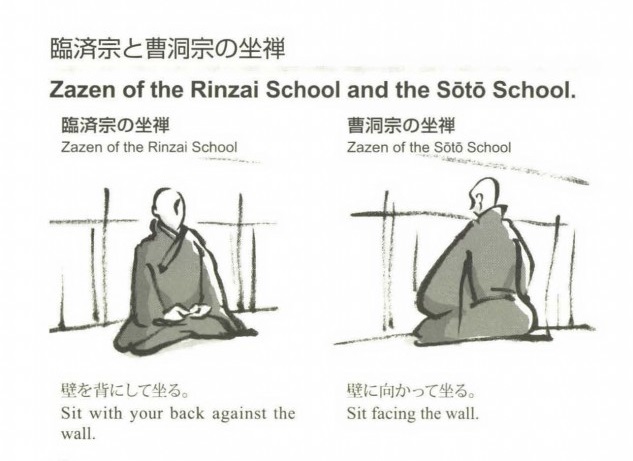
The practice of zazen involves sitting still for long periods of time, focusing on breathing deeply and holding the eyes open. The practitioner must stop thinking about anything else while practicing zazen meditation. He or she must also maintain a calm and focused state of mind. Although savasana is more challenging than traditional savasana it is essential for the development of the mind. Start by sitting in a comfortable, straight position. You can then lock your eyes, and you will be able to sit comfortably in a seated position for at most ten minutes.
Your posture should be correct while performing zazen. It is a good idea that both your knees are on the floor. The distance between the floor and your shoulders should be equal. Your right bigtoe should be placed on top of your left, and vice versa. Your spine should be in a lotus position. Your hands should naturally rest on each leg.

Zazen requires that a practitioner must breathe quietly and mindfully. Don't try to control their breathing. Instead, just allow it to happen. It is okay to take deep, shallow breaths, as well as short, light, regular breaths. Do not force your breathing unless it is absolutely necessary. Instead, allow your breathing to flow naturally. It should be possible to feel a variety of emotions and feelings simultaneously. These are the most common issues that people struggle with. Zazen is a way to achieve inner peace.
The "Hokkaijo In" seated position is considered the most important aspect in zazen. When practicing zazen, it is crucial to sit in a proper seated position. You do this by placing your right palm in your lap, your left hand on top of the right and your left hand in the middle. The Hara (the center) of the human body should be reached lightly by the tips the thumbs.
The practice of the mind is the key to zazen. The hara, or the place of repose is located four inches below the navel. It expands two inches to either side. The Hara, the seat of the heart and the center of the practice, is called the Hara. To achieve this point, the body needs to be balanced. The practitioner must also be calm and unmoving. A peaceful and happy mind is possible only when there is a relaxed heart.

A quiet, dark place is necessary for practicing zazen. It should be the location of a Manjushri Bodhisattva's Buddha statue. The practice should take place in a space with sufficient light. The Buddha is considered the supreme being and can be of benefit to all. The key to this practice is the mind of a zazen practitioner.
FAQ
What are 10 healthy habits you can adopt?
-
Breakfast is a must every day.
-
Don't skip meals.
-
Maintain a balanced diet.
-
Get plenty of water.
-
Take good care of your body.
-
Get enough sleep.
-
Avoid junk foods.
-
Do some exercise every day.
-
Have fun
-
Find new friends
Increase immunity with herbs or supplements
Herbs and natural remedies can be used to boost immune function. Some common examples include garlic, ginger, oregano oil, echinacea, ginkgo biloba, and vitamin C.
These herbal remedies are not meant to replace medical treatment. They may cause side effects such as nausea, diarrhea, stomach cramps, headaches, dizziness, and allergic reactions.
What should I eat?
Eat lots of fruits and vegetables. These vegetables and fruits are rich in vitamins and minerals that will keep your immune system strong. Fruits and veggies are also high in fiber, which makes them filling and helps with digestion. At least five servings of fruits and vegetables should be consumed each day.
Get plenty of water. Water flushes toxins out of the body and helps to feel full between meals. Drink about eight glasses each day.
Choose whole grains over refined grains. Whole grains have all their nutrients intact, including B vitamins, iron, zinc, magnesium, calcium, and protein. Refined grains have been stripped of some of their nutrition.
Sugary drinks should be avoided. Sugary drinks are high in empty calories and can lead to obesity. Instead, you can opt for water or milk, as well as unsweetened herbal teas.
Avoid fast food. Fast food lacks nutritional value. You won't get the energy you need to function well, despite how delicious it may be. Use healthier options, such as soups, sandwiches, salads, and pasta.
Limit alcohol intake. Avoid alcohol as it can cause empty calories and poor nutrition. Limit yourself to no more than two alcoholic beverages a week.
Reduce your consumption of red meat. Red meats can be high in cholesterol and saturated fat. Choose lean cuts such as beef, pork and lamb, chicken, fish, or turkey.
How does an anti-biotic work?
Antibiotics are drugs which destroy harmful bacteria. Antibiotics are used for treating bacterial infections. There are many types of antibiotics. Some are administered topically, while others can be taken orally.
People who have been exposed are often given antibiotics. An oral antibiotic might be prescribed to someone who has been exposed to chicken pox. This will prevent the spread of shingles. An injection of penicillin may be necessary to prevent pneumonia if someone has strep.
A doctor should give antibiotics to children. Side effects of antibiotics can be more dangerous for children than for adults.
Diarrhea, the most common side-effect of antibiotics, is probably diarrhea. Other side effects that could occur include nausea, vomiting and dizziness. These side effects are usually gone once the treatment is complete.
How can you live a healthy life?
Healthy lifestyles include eating right, exercise regularly, getting enough rest, managing stress, having fun, and eating healthy. Eating well means avoiding processed foods, sugar, and unhealthy fats. Exercise is good for your body and muscles. Sleeping well improves concentration and memory. Stress management helps reduce anxiety and depression. Fun is key to staying young and vibrant.
Statistics
- Extra virgin olive oil may benefit heart health, as people who consume it have a lower risk for dying from heart attacks and strokes according to some evidence (57Trusted Source (healthline.com)
- According to the Physical Activity Guidelines for Americans, we should strive for at least 150 minutes of moderate intensity activity each week (54Trusted Source Smoking, harmful use of drugs, and alcohol abuse can all seriously negatively affect your health. (healthline.com)
- nutrients.[17]X Research sourceWhole grains to try include: 100% whole wheat pasta and bread, brown rice, whole grain oats, farro, millet, quinoa, and barley. (wikihow.com)
- WHO recommends reducing saturated fats to less than 10% of total energy intake; reducing trans-fats to less than 1% of total energy intake; and replacing both saturated fats and trans-fats to unsaturated fats. (who.int)
External Links
How To
What does the word "vitamin" mean?
Vitamins are organic substances found naturally in food. Vitamins allow us to absorb nutrients from food. The body cannot make vitamins; therefore, they must be obtained from food.
Two types of vitamins exist: water-soluble vitamin and fat-soluble vitamin. Water soluble vitamins dissolve easily in water. Some examples include vitamin C,B1 and B2 vitamins (thiamine), B2 and riboflavin, B3 and B6 vitamins (niacin), folic acids, biotin, pantothenic acids, and cholesterol. The liver and fat soluble vitamins are stored within the liver and in fatty tissue. You can find vitamin D, E K, A, beta carotene, and other fat-soluble vitamins.
Vitamins are classified based on their biological activity. There are eight main groups of vitamins.
-
A - essential for normal growth and maintenance of health.
-
C - vital for proper nerve function, and energy production.
-
D – Essential for healthy teeth, bones and joints
-
E is required for good vision and reproduction.
-
K – Required for healthy nerves & muscles.
-
P - vital for building strong bones andteeth.
-
Q - aids digestion and absorption of iron.
-
R is required for the production of red blood cells.
The recommended daily allowance (RDA) of vitamins varies depending on age, gender, and physical condition. The U.S. Food and Drug Administration (FDA) sets the RDA values.
For adults over 19, the RDA for vitaminA is 400 micrograms per daily. For fetal development, pregnant women need 600 mg per day. Children ages 1-8 require 900 micrograms per day. Infants below one year old require 700mg per day. But, between 9 months to 12 months, the amount drops to 500mg per day.
Children aged 1-18 years need 800 micrograms daily, while children overweight require 1000 micrograms per days. Children who are severely obese or underweight will need 1200 micrograms each day.
Children between 4 and 8 years old with anemia will need 2200 micrograms daily of vitamin C.
2000 micrograms daily is required for adults over 50 to maintain their general health. Because of their higher nutrient needs, women who are pregnant or nursing need 3000 mg per day.
Adults over 70 years of age need 1500 micrograms per day since they lose about 10% of their muscle mass each decade.
Women who are pregnant and lactating need more nutrients than the RDA. Pregnant women require 4000 micrograms daily during pregnancy, and 2500 micrograms every day after birth. Breastfeeding mothers need 5000 mg per day when breastmilk is being produced.